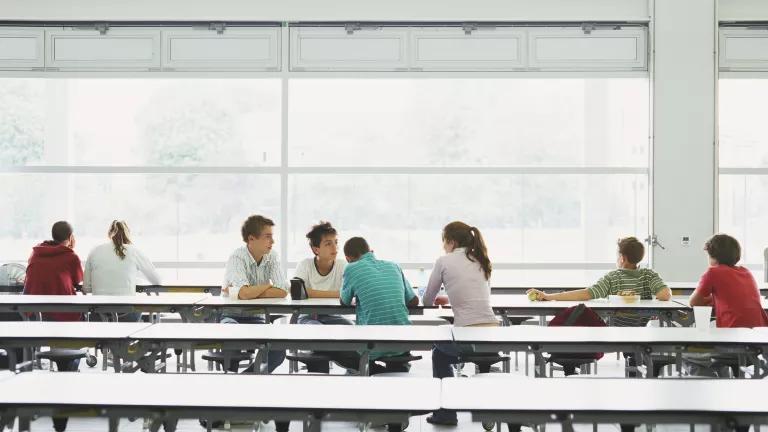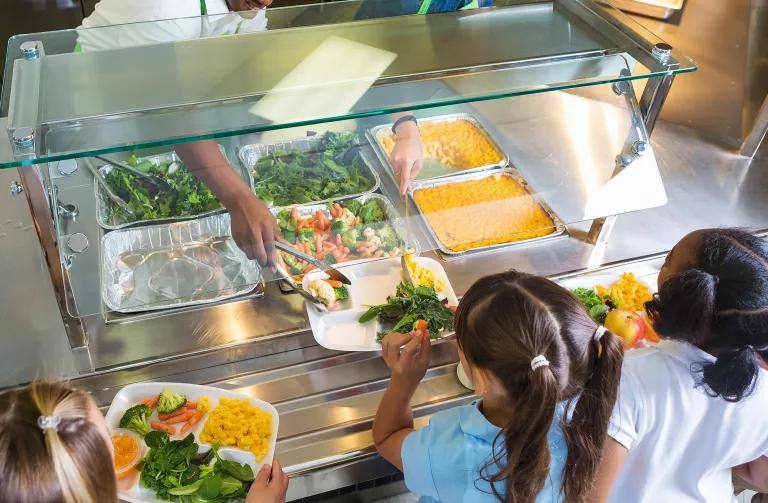Getting a Better School Lunch
By working with schools, parents can make their kids’ cafeteria lunches healthier and more planet-friendly.

Tom Merton/Getty
Picture a school cafeteria lunch. What comes to mind? Pizza, Tater Tots, chicken nuggets? The quality of school food has improved in the last 20 years—thanks in large part to 2010’s Healthy Hunger-Free Kids Act, which mandates that schools serve a fruit and vegetable every day, increase the number of whole-grain foods, and limit trans fats and sodium. Of course, there’s still work to be done. “Many schools are still hard at work increasing fruits and veggies and phasing out more processed foods,” says Margaret Brown, an NRDC staff attorney who spearheads NRDC’s regional food efforts and is working closely with the Urban School Food Alliance, a nonprofit coalition of six of the largest school districts in the United States.
And the potential health impact of improving school meals is enormous. Some 32 million kids eat school meals every day, and for many low-income students, those meals supply more than half their daily calories. And the waste created by all-too-common polystyrene trays is adding to the already-astronomical pollution in our waterways.
It’s great to get excited about making change in your child’s school, but before you march into the principal’s office or a PTA meeting, do your homework. “Talk to the administrators who are involved in food-related decision-making—often the school food director—and ask how the process works and what they’re up against,” Brown says. With an average of $1.30 to spend per child, most public schools face significant challenges. So build relationships first. Then ask, How can I help? “Most schools want to make healthy changes and would welcome parents’ assistance,” Brown says. Here’s where to start.
Strive for a salad bar.
“Getting kids to eat more vegetables and fruits is something we can all get behind,” Brown says. “Salad bars are usually a huge hit because kids like to choose what they eat,” (To reduce waste, suggest posting a sign saying ‘Take What You Want, But Eat What You Take.’) Because the equipment for a salad bar can cost $3,000 or more, you may need to get creative on funding. “I did a lot of grant writing and talked to any business owner who would listen. A lot of them donated funds,” says Jessica Shelly, food services director for Cincinnati Public Schools, which installed salad bars in every one of its schools in less than a year. Let’s Move Salad Bars to Schools, an alliance among chef Ann Cooper and produce associations and grocers whose goal is to have a salad bar in every school in the country, offers additional suggestions.

Steve Debenport/iStock
Check out new vendors.
To improve the quality of cafeteria food in general, visit Focus on the Plate, which lists 50 healthy food products, like poultry free of unnecessary antibiotics and vegetarian burritos as well as the suppliers that offer them. “More and more companies are offering healthier options,” says Kathy Lawrence, cofounder of Focus on the Plate’s parent organization, School Food Focus, which links school districts with healthy food producers and suppliers. “Parents can make a big impact by researching local or regional proprietors who are willing to work within the school’s budget.” Or encourage your school to offer one plant-based entrée every day by sharing recipes and testing them with the staff, suggests Amie Hamlin, executive director of the New York Coalition for Healthy School Food, which has 13 plant-based, kid-approved recipes of its own.
Get fresh and (really) local.
Building a garden has significant upfront costs—as much as $40,000—but a surprising number of companies have made a practice of contributing funding to schools willing to take on the challenge, including Whole Foods and Lowe’s, says Lisa Ely, a mother and TV producer in Valencia, California, who consults with schools on how to build gardens. “I’ve found that the best way to sell schools on the idea is to help them see it as a learning tool for kids, as well as a potential resource for the cafeteria,” she says. “You can get PTAs interested by telling them about research showing that kids who spend 20 minutes outside are better able to focus.” Also, she says, when kids plant and harvest the produce themselves, they’re more likely to eat it.
Lengthen lunchtime.
Fitting lunch into the school day can be a struggle for many schools—kids may get only 20 minutes for lunch or eat as early as 10:45 a.m. “It’s hard to get kids excited about eating their fruits and vegetables when they aren’t hungry yet or simply don’t have the time,” says Brown. One way to ensure that kids are hungry when they hit the cafeteria: Ask your school district to schedule recess before lunch, Lawrence suggests. (Peaceful Playgrounds offers helpful guidance.) In 2014, researchers at Cornell University found that students who had recess first ate 54 percent more fruits and vegetables compared with those who had lunch first. If your school has 20 minutes or fewer for lunch, convince the principal, school board, and other parents that it should be extended by at least 10 minutes; studies also show that kids eat more—and healthier—food when they have more time.
Slash waste.
The first step is a messy one: Sort the cafeteria’s garbage and do a waste audit, so you know what’s being thrown away, suggests Debby Lee Cohen, founder of Cafeteria Culture, an organization aiming to achieve zero-waste school cafeterias. What you’re likely to find: lots of polystyrene trays. “There are 30 million or so daily meals served in U.S. schools—many of those trays end up contributing to the 270 million metric tons of plastic floating in our oceans,” Cohen says. Replacing trays with reusable dishes is the ideal solution, but Cohen points out that many schools no longer have dishwashers. Push for compostable paper food boats (imagine what ballpark hot dogs are served in), even for just one day a week. “When we started Trayless Tuesdays in New York City, we reduced the waste by 20 percent,” she says. "Paper boats cost 3 to 4 cents a piece, about the same as polystyrene." Compostable trays that look more like regular lunch trays are about twice as expensive, so you may need to fund-raise to pay for it, or band together with other districts to lower the price by increasing your purchasing power. The success of Trayless Tuesdays in 2010 led the city to completely eliminate polystyrene foam from schools and other restaurants citywide in 2015. And with NRDC’s assistance, all of the Urban School Food Alliance cities have also committed to ditching polystyrene trays for compostable plates. (For ideas and inspiration, check out Cafeteria Culture’s Sort2Save program.)

Focus on flavor.
Back to that garbage audit. You’ll also likely find lots of uneaten food. And this raises an important point: Serving healthy meals is only half the battle. It needs to taste good, too. Revamping the menu with input from a talented local chef can significantly increase students’ consumption of fruits and vegetables, according to 2015 research at Harvard T.H. Chan School of Public Health. Wellness in the Schools has chefs that will come to schools in New York, New Jersey, Florida, and California and teach the existing kitchen staff how to create nutritious fare that kids will gobble up.
This NRDC.org story is available for online republication by news media outlets or nonprofits under these conditions: The writer(s) must be credited with a byline; you must note prominently that the story was originally published by NRDC.org and link to the original; the story cannot be edited (beyond simple things such as grammar); you can’t resell the story in any form or grant republishing rights to other outlets; you can’t republish our material wholesale or automatically—you need to select stories individually; you can’t republish the photos or graphics on our site without specific permission; you should drop us a note to let us know when you’ve used one of our stories.

How to Turn Your Patch of Earth From Barren to Bountiful
The Pesticide in Your Crisper Drawer
Attention Food Lovers: Eco-Conscious Eating Isn’t All About Distance